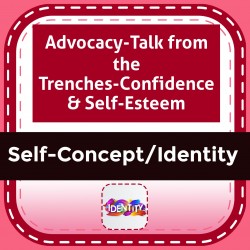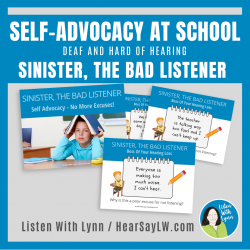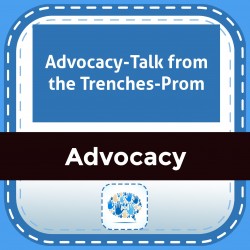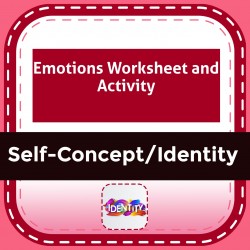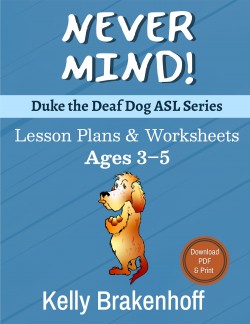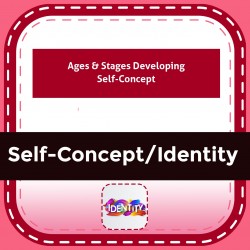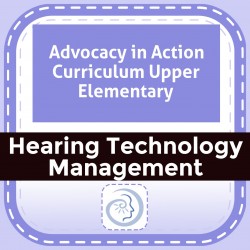Ability Levels
Categories
Resource Types
Age/Grade Range
CCSS
Anchor Standard
Speaking & Listening
Language
Reading
Advocacy-Talk from the Trenches-Confidence & Self-Esteem
$ 2
Engage teens in discussion and goal-setting for future success as a young adult with hearing loss. See BUNDLE at S0XSOC739.
Self-Advocacy Sinister, The Bad Listener
$ 5
This resource is a hilarious self-advocacy activity. Your students will say it is their favorite activity and, you will know they are learning to become the boss of their hearing loss. It was created
...
to encourage self-advocacy skills in children who are deaf and hard of hearing but is effective when targeting listening skills in all kids.The Premise: Sinister has two ears, wears great hearing devices, and has been in listening and language therapy since he was a toddler. But, it doesn’t matter. Sinister is a BAD listener! He doesn’t try and makes up excuses for not listening. Sinister gets in a whole lot of trouble because he doesn’t listen.The adult leads a discussion using Sinister’s poor excuses for not listening. Kids love imagining the trouble Sinister gets himself into because he doesn’t listen. This activity is an easy, no-prep way to encourage the child to be Boss of Your Hearing Loss. Parents can use it at home, teachers and therapists both face-to-face and during tele-practice. While not age-specific it has been successfully used with kids in 1st grade and up through middle school. This resource can be easily leveled up or down to meet various children's goals and needs.Sinister The Bad Listener requires no prep or planning because everything is in this resource. It can be easily used by parents at home, teachers, and therapists both face-to-face and on tele-platforms. This Digital - No Print resource can be opened and played with your favorite PDF reader app on a tablet. When playing on a computer, open and use a PDF reader such as the free Adobe Acrobat Reader DC. Boom LearningSinister the Bad Listener is also available as a Boom Deck in the Listen With Lynn Boom Learning store. Please note: Sinister The Bad Listener is a serve-and-return conversational game between the adult and the listener. There is no audio component or sound bytes included.◈ ◈ ◈ ◈ ◈ ◈ ◈ ◈ ◈ ◈ ◈ ◈ ◈ ◈ ◈ ◈ ◈ ◈ ◈ ◈ ◈ ◈ ◈ ◈ ◈ ◈ ◈ ◈ ◈ ◈ ◈ ◈You'll love all these resources for kids with hearing loss and self-advocacy activities!❤ ❤ Check out the Bundle of 8 Self-Advocacy $$ saving bundle! SELF-ADVOCACY Tips For Communication Success (Free)SELF-ADVOCACY The 5 L's For Listening (Free)SELF-ADVOCACY This or That?SELF-ADVOCACY Bluffing Never Have I Ever ActivitySELF-ADVOCACY Role Play Real-Life ConnectionsSELF-ADVOCACY Scenarios At Group Gatherings & CelebrationsSELF-ADVOCACY Sinister The Bad ListenerSELF-ADVOCACY Scenarios - Turning Lemons Into LemonadeSELF-ADVOCACY Perk Up Your Ears (Ear-related sayings and idioms)SELF-ADVOCACY Listen & Draw Directions◈ ◈ ◈ ◈ ◈ ◈ ◈ ◈ ◈ ◈ ◈ ◈ ◈ ◈ ◈ ◈ ◈ ◈ ◈ ◈ ◈ ◈ ◈ ◈ CUSTOMER TIPS:➼ Click here to stay updated!➼ Be the first to know about freebies, sales, and product launches.➼ New products are 50% off the first 24 hours
STAY CONNECTED:✧ Sign-up here for the Listen With Lynn Email✧ Follow on Facebook
✧ Follow on Instagram
✧ Feel free to email me with questions, before purchasing this resource or anytime later.
❤ Keep up your excellent work. I am blessed to help along the way. Thanks so much! Lynn
Advocacy-Talk from the Trenches-Prom
$ 2
Engage teens in discussion and goal-setting for future success as a young adult with hearing loss. See BUNDLE at S0XSOC739.
Emotions Worksheet and Activity
$ 195
These
two activities support student learning about feeling words and their
meanings.
...
Never Mind (Duke the Deaf Dog ASL Series) Printable Workbook Ages 3-5
$ 799
No prep time, just print and go!Every student needs to learn the social emotional impact of being left out of conversations and how to include their peers. Download this complete lesson plan written b
...
y a certified Deaf Educator for ages 3 to 5 and Pre-K to K. Seven printable worksheets are included as companions to the picture book: Never Mind (Duke the Deaf Dog ASL Series #1), by Kelly Brakenhoff: two different cover art options, three worksheets, and two coloring pages. Video tutorial links included for practicing the ASL vocabulary and an ASL version of the complete story performed by a Deaf College Instructor.There are many creative ways to use this workbook in your classroom.Have a small group read the book together, while other small groups are reading a different book. Have the group of students complete the worksheets and discuss their responses to the social emotional aspects of the story. The students can break into pairs to practice the ASL signs used in the book.Have a student read the book independently, complete the worksheets, and view the ASL video tutorials online.Read aloud the story to your class and/or watch the video version of the story in ASL with the link provided. Use the lesson plan and follow the discussion questions with a full class or in smaller groups.This packet is also perfect to supplement homeschooling curriculum.
Advocacy - Supplement to Steps to Success BUNDLE
$ 1095
This bundle of teacher information, worksheets, and activities include a range of advocacy topics from college preparation, to living indpendently. Students will acquire new vocabulary, use critical
...
thinking skills to solve problems, opportunities for self-discovery and discussion, and above all learn the who, what, when, how, and why of self-advocacy. Though some activities can be modified for upper elementary, most activities are for intermediate to advanced learners. 41 pages. Collected IDs in the BUNDLE: S0XHLU0740, S0XHLU0741, S0XHLU0742, S0XADV0743, S0XSOC0744, S0XSM0745, S0XADV0748.
Ages & Stages Developing Self-Concept
$ 0
Self-concept develops from infancy through childhood. This resource describes the stages of self-concept development for ages birth through 2 years, 3-4 years, and 5-6 years. Useful for educational pl
...
anning and understanding behavior, along with the need to strengthen self-concept development.
Advocacy in Action Curriculum Upper Elementary
$ 13
Complete curriculum guidance and scenarios for instruction in amplification (including hearing aids, cochlear implants, and FM systems), hearing loss basics including audiograms and ear anatomy, liste
...
ning environments, and social awareness situations.
Farts Make Noise (Duke the Deaf Dog ASL Series) Printable Workbook Ages 3-5
$ 799
No prep time, just print and go!Every student needs to learn that some noises are loud, some are quiet, and some noises are not polite. Students will also learn that being deaf or hard of hearing can
...
be positive.Download this complete lesson plan written by a certified Deaf Educator for ages 3 to 5 and Pre-K to K.Seven printable worksheets are included as companions to the picture book: Farts Make Noise (Duke the Deaf Dog ASL Series #2), by Kelly Brakenhoff: two different cover art options, three worksheets, and two coloring pages. Video tutorial links are included for practicing the ASL vocabulary and an ASL version of the complete story performed by a Deaf College Instructor.There are many creative ways to use this workbook in your classroom.Have a small group read the book together, while other small groups are reading a different book. Have the group of students complete the worksheets and discuss their responses to the social emotional aspects of the story. The students can break into pairs to practice the ASL signs used in the book.Have a student read the book independently, complete the worksheets, and view the ASL video tutorials online.Read aloud the story to your class and/or watch the video version of the story in ASL with the link provided. Use the lesson plan and follow the discussion questions with a full class or in smaller groups.This packet is also perfect to supplement homeschooling curriculum.
 Your browser is out of date. For best experience switch to latest updated Browser.
Your browser is out of date. For best experience switch to latest updated Browser.
 Get Chrome
Get Chrome Get Edge
Get Edge Get Firefox
Get Firefox